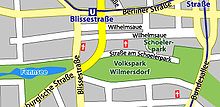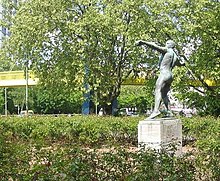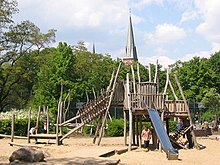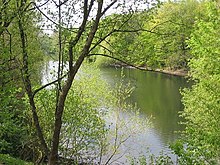Volkspark Wilmersdorf

The public green and recreation area Volkspark Wilmersdorf is located in the Wilmersdorf district of the Berlin district of Charlottenburg-Wilmersdorf near the Wilhelmsaue street , the former center of Alt-Wilmersdorf. Together with the neighboring Schöneberg Rudolph-Wilde-Park , the Volkspark forms an inner-city green corridor around 2.5 kilometers long and only around 150 meters wide. Wilmersdorfer's share is around 1850 meters, stretching from Rudolph-Wilde-Park on Kufsteiner Strasse in the east to the city ring in the west. The park, with 12.3 hectares of Wilmersdorf's largest green area, includes the Fennsee at the western exit and two sports fields between Uhlandstrasse and Bundesallee , where the Wilmersdorfer See was located.
history
The park was an ambitious project by the affluent community of Deutsch-Wilmersdorf (municipal rights 1906). The planning of the "Seepark", which had been pursued since 1899, had been in the hands of the community head gardener Richard Thieme since 1904 .
After 1903, between Blissestrasse and Rudolstädter Strasse , a rain basin was dug in the non-buildable Fenn channel (Fennsee). The Wilmersdorfer See increasingly silted up. Thiemes' overall design from 1912 envisaged a design in the mixed park style of the 19th century and was divided into three parts.
- Part A of the Rudolph-Wilde-Park in Schöneberg (border: Kufsteiner Straße), which was laid out between 1910 and 1912, via Prinzregentenstraße to Kaiserallee (today: Bundesallee ), executed in 1913
- Part B from Kaiserallee to Augustastraße (today: Blissestraße), carried out according to a new design between 1933 and 1936
- Part C from Augustastraße to Rudolstädter Straße, executed from 1913 to 1920
Between 1917 and 1945 the Volkspark Wilmersdorf was called Hindenburgpark .
geology

Geologically, the Volkspark Wilmersdorf forms part of an Ice Age side channel of the glacial channel of the Grunewald chain of lakes . The formerly swampy lowland (Fenn) extends from the Schöneberg Town Hall over the Volkspark and Fennsee to the Herthasee and meets the Grunewaldrinne at Koenigssee . Today, the lowland west of the Fennsee between the city ring and the Hubertussee is interrupted for around 2200 meters by built-up areas, various sports facilities and by the Wilmersdorf summer pool . Various boulders in the entire park area illustrate the geologically young soil design in Berlin.
Wilmersdorf seaside resort
The former Wilmersdorfer See gave the park the name "Seepark" in the first few years. In the second half of the 19th century, various farmers from Schöneberg and Wilmersdorf, who went down in history as “farmers with millions ”, gained wealth through sales of land to construction investors on the outskirts of the fast-growing city of Berlin .
One of these millions of farmers was the Wilmersdorf restaurateur Otto Schramm , who built a bathing establishment on the lake and the then famous Schramm dance palace . “Let's go to Schramm” was one of the winged words of Berlin day trippers in the 1880s . Younger officers and impoverished aristocrats are said to have been on the lookout for the daughters of the millions of farmers here with great success.
Outline of the park
The elongated park consists of three different areas, which are strongly separated by streets, which are shown below from east to west.
Eastern area (A)
The eastern area extends from the neighboring Schöneberger Rudolph-Wilde-Park to the Bundesallee. Thiemes design adapted in its landscape form to the existing Schöneberg part. It contained an oval toddler playground in the far east. The meadow east of Prinzregentenstrasse was supposed to be a playground. Natural stone stairs with balustrades and vases led down from both sides of Prinzregentenstrasse . The part west of Prinzregentenstrasse was intended for adults. To the west of this street was an octagonal flower garden. A semicircular square opened up towards the Kaiserallee, on which were also white wooden benches with lattice backs.
Immediately next to Rudolph-Wilde-Park, near the former RIAS building (today: Deutschlandradio ) is the largest playground in the park, which is already part of the Wilmersdorf district. The following main part consists of a landscape park with lawns. With the expansion of the Bundesallee (formerly: Kaiserallee ) to several lanes , the following central park area is clearly separated and connected via the “Volksparksteg”, which has spanned the Bundesallee for pedestrians and cyclists since 1971. The bronze sculpture “Spear Thrower” by Karl Möbius from 1921, which was melted down in 1944 and re-cast in 1954, is located below the footbridge . The eastern area is crossed by the little-traveled Prinzregentenstraße, which must be driven through at walking pace in the parking area.
At Durlacher Straße 14 (today: No. 15 / 15a) on the south side of the park was the studio and residential house Zum Bieber , built by Wilhelm Walther in 1893 and 1894 , in which in the first half of the 20th century the Artists Ernst Ludwig Kirchner , Max Pechstein , Gerhard Marcks , Richard Scheibe , Clara Siewert and Elisabeth Siewert worked and / or lived. The Bieberbau restaurant located in the building is a listed building.
Middle area (B)
This area extends from the Bundesallee to the Uhland- / Mecklenburgische Strasse street , which in turn sharply separates the western area with the Fennsee. The middle area of the park begins with a meadow and garden area, which is followed by another larger playground, including a basketball court . This is followed by the sports facilities with two soccer fields on the grounds of the filled in Wilmersdorfer See. The wide, tree-lined paths that line the entire park on the north and south edges also lead past the sports fields.
Part B was planned as the most attractively designed centerpiece. Thiemes design contained geometric ornamental spaces on both sides of today's Bundesallee, a geometric flower parterre with flower beds, a large curved foyer with an orchestra room, lavatory and refreshment hall. From here you should be able to overlook the Wilmersdorfer See as a central element in which the Auenkirche from 1897 is reflected. Due to putrefactive smells, the Wilmersdorfer See was filled with rubbish and slag between 1920 and 1924, but it kept sagging.
A stricter playground was planned on Augustastrasse with benches for spectators.
In 1921, Thieme was forced to reschedule Part B. The playground in the east, a large rectangular playing field in the middle, and a paved meadow in the west, were lined up as a large room on an axis. The axis was bent because of the course of the property. It led over to the place with the javelin thrower, so that section A was also connected in terms of design.
After the seizure of the Nazis of Part B was carried out with vigor 1933-1936. The original draft was revised again. The hope of preserving the lake was buried. The result was tight monumentality. The idea of the bent axis that connected the parts of the park was preserved. A sunbathing lawn, a flower arrangement, special gardens, a playground, an avenue of plane trees , instead of the lake a sports field, further east a playground with the boxer sculpture from Fehrbelliner Platz and a sundial that was later moved to the extended Uhlandstraße. Two shelters were built to the west of Kaiserallee, the larger one in the north with a milk bar.
Part B was completely redesigned in 1952/1953. A larger meadow and a shrub and flower garden were obtained in the eastern part, in which the two shelters were taken over in a simplified form. In 1960 Eberhard Fink and Karl Schmid revised the part again. Any creative connection between the parts has since been abandoned.
Western area (C)
For the difficult part of the terrain, part C, with the collecting basin, Thieme did without any particular attractions. The viaduct with the subway was built here in 1913 in the course of Barstrasse , which divides this part of the park into two roughly equal parts. The original monumental arcades with two walkways for walkers in the park must have been a very attractive element. The ends of the changing halls connected to the park paths. In the west the park ended with a central flight of stairs .
After structural damage caused by subsidence , the Fennbrücke had to be replaced 1934/1935, the corridors disappeared. The park was thereby deprived of its main attraction. The changes that became necessary were serious. Since then, it is no longer possible to pass under the bridge. The paths had to be led across Barstrasse.
→ See: Fennsee
Games, sports and leisure
In contrast to the neighboring Schöneberger Rudolph-Wilde-Park, the Volkspark Wilmersdorf has a large number of leisure facilities for children, young people and adults, which are integrated into the green areas in an attractive landscape and, apart from the football fields, are freely accessible. In addition to the two large football fields, there are many stone table tennis tables with metal nets, some of which are integrated into the playgrounds. A beautiful and well-kept basketball court is very popular with young people. In addition, the park has a tennis court , bocce ball and a mini golf course . The shady side paths are popular with joggers - among the most beautiful jogging and walking routes through downtown Berlin , the Senate suggests route No. 9, a 3.8-kilometer stretch in the green corridor.
Deep in the shade of old chestnuts is a place with eight stone tables for board or card games , each with four seats, with chess and mill patterns already embedded in the stone. The numerous playgrounds are a special feature of the park. There are smaller spaces for toddlers, medium-sized spaces with various climbing frames, swings, slides , seesaws and sandboxes for all age groups and especially the extensive and varied playground at the RIAS, which also has an adventure area . A small dog exercise area is available for dog lovers. Kiosks and bars on the edge of the park provide park guests with drinks and food.
See in more detail
- to the "million farmers": Wilmersdorfer See
- to the term "Fenn": Grunewaldseenkette
literature
- Max Kretzer : The Farmer of Millions , 2 volumes, Leipzig 1891 (also as a play 1891)
Web links
- District Office Charlottenburg-Wilmersdorf, walk through the neighborhood with District Mayor Monika Thiemen (May 10, 2003)
- Senate Department, Jogging Route No. 9 (PDF file; 21 kB)
- History and more pictures
- Entry in the Berlin State Monument List
Individual evidence
- ↑ Georg-Kolbe-Museum : Ick to paint inside very beautiful but very difficult. The black acrobat Sam inspires Ernst Ludwig Kirchner, Gerhard Marcks and Richard Scheibe. (PDF; 33 kB) Section 5 of the exhibition Magic of the nude model ( Memento of the original from February 28, 2013 in the Internet Archive ) Info: The archive link has been inserted automatically and has not yet been checked. Please check the original and archive link according to the instructions and then remove this notice. 2012/2013.
- ^ Roman Zieglgänsberger (editor): Clara Siewert. Between dream and reality. With contributions by Renate Berger, Michael Kotterer and Roman Zieglgänsberger. Ed .: Kunstforum Ostdeutsche Galerie Regensburg, Regensburg 2008; ISBN 978-3-89188-116-3 , pp. 22, 25, 35 (note 48).
- ↑ Entry in the Berlin State Monument List
Coordinates: 52 ° 29 ′ 1 ″ N , 13 ° 19 ′ 27 ″ E









